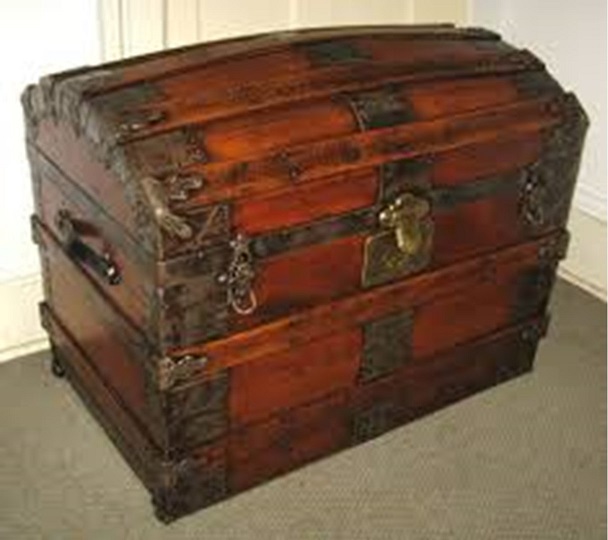Suitcases in olden times were made of wood and steel. They were popularly known as trunks or chests. Why do you think these trunks had to be carried or dragged when wheel was invented several thousand years before? Haven’t innovations happened in the luggage industry? I believe the reason for taking decades to put wheel in luggage was the lack of design thinking. As explained in my earlier post, Innovation is an ‘end state’ or a ‘dream’ that a person or a group has and if ‘design thinking’ is applied to achieve that end state the final outcome is likely to be far superior.
In the late 16th century, the Oxford English dictionary added the word “luggage”. The word at that time meant ‘inconveniently heavy baggage’ and it came from the verb ‘lug’.
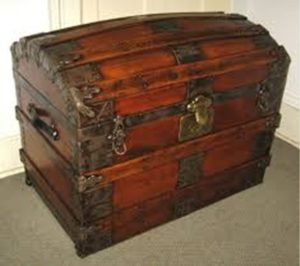
Portable, carry-around suitcases with hinges and latches have only existed since the early 1800’s and have been in popular use since the mid-19th century. The first hand-carried personal cases were wood boxes with protective coverings and corner-guards because the rough roads and sea would make the trunks slide and hit one another. The best trunks were waterproofed with canvas or tree sap to avoid water leaking into them during the sea travel.
When train and ship travel became the common long-haul methods of travel, need for personal bags that one person could carry arose and craftsmen started building moderate-sized boxes with hinged openings and covered exteriors with stretched hides or woven wool. They developed locks, hinges, straps and latches…a handle on top and the suitcase was born.
In 1858, Louis Vuitton introduced a trunk that had flat top and flat bottom so as to allow them to be stacked and easily transported. Previously, trunks had rounded tops to facilitate water run-off. When Phileas Fogg the protagonist of the 1873 novel ‘Around the World in 80 Days’, decided to circle the globe, he didn’t take a suitcase. “We’ll have no trunks,” he said to his servant Passepartout, “only a carpet bag, with two shirts and three pairs of stockings for me, and the same for you. We’ll buy our clothes on the way.” Dragging trunks from one steamship to railroad to carriage to hot air balloon would have made it impossible for him to make his movements fast.

The tourism in those days was meant for rich who had an army of servants. The design of suitcases resulted in railway porters and hotel bellhops. Suitcases began as an afterthought in the luggage and leather goods business, but they soon became the very symbol of travel. An 1897 wholesale price list included the words “suit case” only twice in a 20-page list of luggage types. In a 1907 T. Eaton & Co. catalog, trunks took up a full page while suitcases shared a page with club bags and valises. In a 1911 United Company catalog, however, around 40 percent of the advertisements were for suitcases. (It’s worth pointing out that these catalogs were from North America, where migration required people—and not just the wealthy—to carry their own belongings far and often)

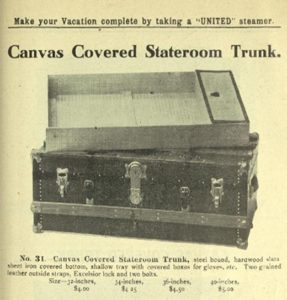
In 1887, AP Roberts patented a wheel trunk that had an inclined base with wheels.

Late 19th century saw the beginning of mass tourism as opposed to pilgrimages (mostly to Jerusalem) or migration to industrial towns. Travel wasn’t just for the wealthy anymore. The travel witnessed a change in preferences – as airports became bigger, the cost of flight reduced, more people could afford, and far more women began traveling alone – All this created a focus for convenience. Finally, the suitcase acquired wheels as people didn’t prefer porters and bellhops. In 1947, John M Hendrick patented wheeled suitcase in which the wheel was on the vertical side at the bottom that got in contact when the suitcase was lifted.
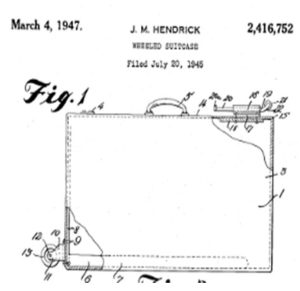
The wood constructed suitcases ended somewhere in the late 1950s or early 60s, giving way to metal frames and plastic/composite shells. Flights had increased their passengers by several times – from 17 million in 1949 to close to 500 million in 1970
There is an interesting story about the wheeled luggage – In the 20th century, during the British Raj in India, Maharani of Nadir arrived at the annual Howrah Durbar (an official reception) atop a wheeled, elephant-drawn portmanteau-armoire-type carry-all. A British colonel drew up a sketch inspired by her impressive luggage and applied in London for a patent. There are multiple reasons cited for the colonel’s patent application not getting through (one reason was that the idea was too feminine for macho men). A month later Queen Victoria graciously awarded her husband Prince Albert three gold medals for his invention, the ‘Travelling Carry-All, Omni-Conveyance, Bewheeled.’

Wheeled luggage was patented in 1974 by Bernard Sadow when baggage handling became perhaps the single biggest difficulty encountered by air passengers. Sadow attributed the late invention of luggage on wheels to a ‘macho thing’ where ‘men would not accept suitcases with wheels’. Some others attributed the late invention to the abundance of luggage porters with carts. This patent that lasted just two years had four wheels (uncomfortable as one had to bend). Imagine, this took place five years after the man landed on the moon!

The familiar suitcase with two wheels that could be rolled with an extendable handle was created in 1987 by then Northwest Airlines pilot Robert Plath for himself. He called it a Rollaboard and trademarked the name. He was an avid tinkerer who affixed two wheels and a long handle to suitcases that rolled upright, rather than being towed flat like Mr. Sadow’s four-wheeled models. Robert initially sold his Rollaboards to fellow flight crew members and when passengers in airports saw flight attendants moving briskly through airports with their Rollaboards in tow with their visible biceps, a whole new market was created. Within a few years Robert started Travelpro International, a major luggage company. Travelpro popularized the telescoping handle with the two wheels.
Later in 1993, Don Ku filed a patent for ‘Wheeled suitcase of luggage support with collapsible towing handle’ that took the collapsible unit to the outside of suitcase thereby creating more space inside.
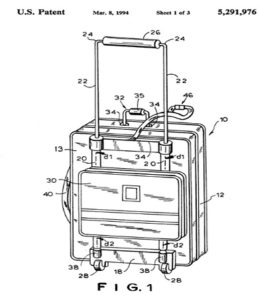
Finally, it was only in 2014 that the patent for four-wheel spinner was filed.
I believe that every inventor described above had a particular end product in mind because of a brainwave/idea that would simplify the process of ‘carrying’ or more precisely ‘dragging’ the luggage. If the design thinking methods were applied early enough, immediately after the idea was born, I am sure the number of years it would have taken for us to get the four-wheel spinner would have been far too less. I like the analogies that design thinking uses to encourage innovators to think beyond the original imagery that the innovator has. In this case of suitcase, words like ‘companion’, ‘guide’, ‘carrier’ instead of ‘dragging’ and ‘lugging’ would have surely skipped a few steps in the evolution of suitcase. The only barrier in achieving this is the mindset of the innovator who usually gets fascinated (obstinated) by the original idea. Not all innovations have suffered due to lack of design thinking – some innovators have been excellent design thinkers (Steve Jobs). The innovators today must worry less because the subject of design thinking has been embellished in the last few years with frameworks, examples and tools, which make it easy to use. Design thinking has some limitations, which I have discussed later.
Who in the organization should encourage and enable employees to use design thinking? – Chief Innovation Officer/Evangelist.
References:
- https://en.wikipedia.org/wiki/Baggage
- https://en.wikipedia.org/wiki/Suitcase
- https://www.fastcompany.com/3003362/story-wheelie-suitcase-and-importance-implementing-innovation
- https://archive.org/details/goldsilversmiths00uwjcuoft
- https://www.google.com/patents/US3653474?dq=wheeled+suitcase+1970&hl=en&sa=X&ei=37teU7_sDsjKsAS4hIEw&ved=0CDUQ6AEwAA
- https://www.smithsonianmag.com/history/history-humble-suitcase-180951376/
- http://www.boombaggage.ca/the-history-of-luggage-101/
- https://nowheremag.com/2013/09/carry-on-wheelies/
- http://oooo.bluesmart.com/2016/03/07/3-luggage-innovations-that-changed-travel/
- http://www.lvtrunks.com/history#.WivF91WWb4Y
- http://www.trazeetravel.com/trends/a-brief-history-of-the-suitcase.php
- https://visual.ly/community/infographic/travel/evolution-luggage
- https://www.google.ch/patents/US5291976
- http://www.nytimes.com/2010/10/05/business/05road.html
- http://www.foxnews.com/travel/2014/05/30/history-luggage.html

